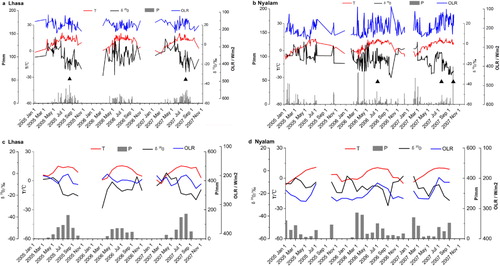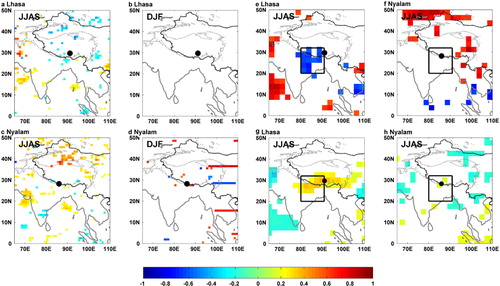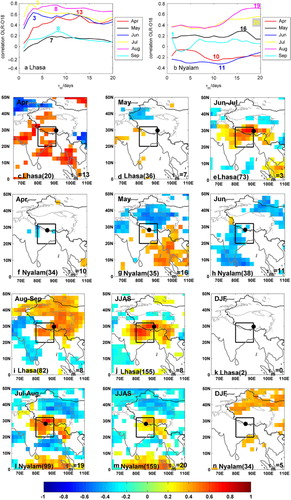Figures & data
Fig. 1 2005–2007 averaged Outgoing Long Wave radiation (OLR, shading, downloaded from http://www.esrl.noaa.gov/psd/data/gridded/data.interp_OLR.html) showing convective activity as minima in OLR due to cold cloud tops and 500 hpa zonal wind speed (dashed contours) and wind vectors (arrows, downloaded from http://www.esrl.noaa.gov/psd/data). The zonal wind isolines highlight the Tibetan high-pressure system. The surface wind vectors clearly depict the Indian monsoon flow and the westerlies (a) in summer (JJAS) and (b) in winter (DJF).

Table 1. Summary of precipitation data at Lhasa and Nyalam stations from 2005 to 2007
Fig. 2 Temporal variations of daily precipitation δ18O and local temperature, precipitation amount and OLR at Lhasa (a) and Nyalam (b) from 2005 to 2007. Seasonal patterns of monthly weighted precipitation δ18O, corresponding monthly mean temperature, precipitation amount and local OLR at Lhasa (c) and Nyalam (d) during 2005–2007. The black triangles highlight extreme events (identified from peak precipitation combined with depleted δ18O) at both stations on 16 August 2005, 17 August 2007, 24 September 2007, 2 July 2006 and 20 July 2007.

Fig. 3 Temporal correlations between daily precipitation δ18O at Lhasa (a) or at Nyalam (c) and precipitation amount in other grid points of the domain, in JJAS. (b) and (d): same as (a) and (c) but for DJF. (e) and (f): same as (a) and (c) but for monthly data. Temporal correlations between daily precipitation δ18O at Lhasa (g) or at Nyalam (h) and OLR in other grid points of the domain, in JJAS. On all maps, only correlations significant at the 95% confidence level are shown. The black rectangle shows the Zone 1 region discussed in the text.

Fig. 4 Correlation coefficient (R) between the precipitation δ18O and local OLR averaged over J m days (period prior to the event over which the convective activity is averaged) at Lhasa (a) and Nyalam (b). The numbers indicate the maximum values of J m days for each period. (c) Correlation between the δ18O of events at Lhasa and the OLR averaged over the 13 d preceding each event in April, (d) 7 d preceding each event in May, (e) 3 d preceding each event in June–July, (i) 8 d preceding each event in August–September, and (j) 8 d preceding each event in JJAS. (k) No correlation can be calculated in DJF at Lhasa as only two events occurred. (f) Correlation between the δ18O of events at Nyalam and the OLR averaged over the 10 d preceding each event in April, (g) 16 d preceding each event in May, (h) 11 d preceding each event in June, (l) 19 d preceding each event in July–August, (m) 20 d preceding each event in JJAS and (n) 5 d preceding each event in DJF. The numbers in brackets indicate the number of events in different months. The black rectangle shows the Zone 1 region discussed in the text.

Fig. 5 (a–j) Back trajectories simulated by HYSPLT for Lhasa and Nyalam in different months (January, June, July, August and September). The percentage shows the frequency of each clustered back trajectory. Correlation coefficient (R) between the precipitation δ18O and OLR along the back trajectory averaged over J m days (period prior to the event over which the convective activity is averaged) at Lhasa (k) and Nyalam (l). The numbers indicate the maximum values of J m days for each period.

Fig. 6 Comparison of daily temperature from the zoomed LMDZiso simulations and observations at Lhasa (a) and Nyalam (d) during the observed period of 2005–2007; (b) and (e) same as (a) and (d) for precipitation amount; (c) and (f) same as (a) and (d) for precipitation δ18O. Relationships between precipitation amount and precipitation frequency at Lhasa (g) and Nyalam (h) from observations and zoomed LMDZiso simulations. The precipitation categories are calculated with steps of 2.5 mm, with events above 20 mm classified in one category.

Fig. 7 Temporal correlation between temperature and precipitation δ18O at Lhasa (a) and Nyalam (c) from zoomed LMDZiso simulations in summer (JJAS); (b) and (d) same as (a) and (c) for winter (DJF); (e) and (g) same as (a) and (c) for precipitation amount; (f) and (h) same as (e) and (g) for winter (DJF). The black rectangle shows the Zone 1, and the green rectangle shows the Zone 2.
